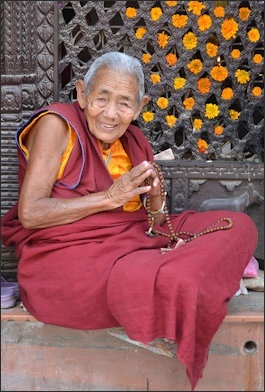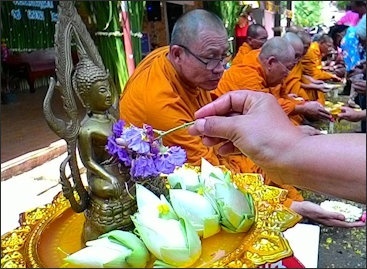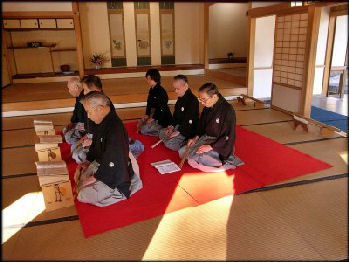BUDDHIST PRACTICES

family praying at a temple in Myanmar
Buddhism practice often involves veneration, or the showing of respect and admiration towards images of the Buddha, other buddhas, and bodhisattvas. For Theravada Buddhists, the Buddha is the primary object of veneration, but for Mahayana Buddhists, a number of buddhas and bodhisattvas are venerated. Veneration is demonstrated with offering of flowers, burning incense,, water in beautiful bowls and fruits to statues or painting of The Buddha or bodhisattvas or a relic of a buddha and an important Buddhist figure.[Source: Encyclopedia.com]
The path to Enlightenment is said to be through the practice and development of morality, meditation and wisdom. One important form of religious practice in Buddhism is dana, or generosity. It taps into the relationship between the lay community and the monks and nuns — a key element of Buddhism. Monks and nuns represent a higher form of spiritual attainment and share their knowledge with lay people. In return, Buddhist lay people supports the monks and nuns with offerings of gifts and food. Theravada lay Buddhists give food to monks daily when the monks go on their begging rounds. Lay people may also help with temple chores, cooking and washing for the monks. In some Theravada countries, lay people provide all the food, clothing, and medicine for the sangha (monk community).
Buddhists can practices their faith both at home or at a temple. It is not considered essential to go to a temple and worship with others. At home, Buddhists often set aside a room or a part of a room as a shrine that includes a statue of Buddha, candles, and an incense burner. The path to Enlightenment is said to be through the practice and development of morality, meditation and wisdom. One of the main goals of Buddhist followers is to earn merit — Buddhist brownie points which help a Buddhist ascend to higher reincarnation levels and eventually reach the state of enlightenment and Nirvana. Earning merit is essentially the same thing as earning good karma and has been described as a “spiritual bank account” in which “doing bad things are withdrawals; making merit is a deposit.”
In Buddhism, there is no equivalent of a Sabbath (a special day of the week for acting particularly religious). Nor is there anything like a mass or liturgy over which a priest presides. Followers visit temples whenever the feel like it, particularly when they want to pray for something in particular, during festivals and holidays or on auspicious days defined by the lunar calendar — notably on full, new and quarter moons, which occur roughly every seven days.
Websites and Resources on Buddhism: Buddha Net buddhanet.net/e-learning/basic-guide ; Internet Sacred Texts Archive sacred-texts.com/bud/index ; Introduction to Buddhism webspace.ship.edu/cgboer/buddhaintro ; Early Buddhist texts, translations, and parallels, SuttaCentral suttacentral.net ; East Asian Buddhist Studies: A Reference Guide, UCLA web.archive.org ; View on Buddhism viewonbuddhism.org ; Tricycle: The Buddhist Review tricycle.org ; BBC - Religion: Buddhism bbc.co.uk/religion
RECOMMENDED BOOKS:
“Everyday Buddhism: Real-Life Buddhist Teachings & Practices For Real Change”
by Wendy Haylett Amazon.com ;
“Pearl of Wisdom (Buddhist Prayers and Practices) by Thubten Chodron Amazon.com ;
“The Essentials of Buddhist Meditation” by Shramana Zhiyi, Bhikshu Dharmamitra Amazon.com ;
“Guided Buddhist Meditations: Essential “Practices on the Stages of the Path” by Thubten Chodron and Dalai Lama Amazon.com ;
“Samsara, Nirvana, and Buddha Nature” by His Holiness the Dalai Lama and Thubten Chodron Amazon.com ;
“Buddhist Scriptures” by Donald Lopez (Penguin Classics) Amazon.com ;
“What the Buddha Taught” by Walpola Rahula Amazon.com ;
“In the Buddha's Words: Anthology of Discourses from the Pali Canon” with Bhikkhu Bodhi, the Dalai Lama Amazon.com ;
“The Heart of the Buddha's Teaching” by Thich Nhat Hanh Amazon.com ;
“Mindfulness in Plain English Paperback” by Bhante Bhante Gunaratana (Author) Amazon.com ;
“The Heart of the Buddha's Teaching” by Thich Nhat Hanh Amazon.com ;
“The Heart Sutra: A Comprehensive Guide to the Classic of Mahayana Buddhism”
by Kazuaki Tanahashi Amazon.com ;
“The Lotus Sutra: A Contemporary Translation of a Buddhist Classic”
by Gene Reeves Amazon.com ;
“The Dhammapada” (Easwaran's Classics of Indian Spirituality) Amazon.com
How to Practice Buddhism
On how to put Buddhism into practice, Yat-Biu Ching, a businessman and author of books on Buddhism, wrote: “Every Buddhist who practises Buddhism must go through four stages: 1) believing; 2) understanding; 3) doing; and 4) proving. [Source: Yat-Biu Ching +/]
“1) Believing: Once a person decides to become a Buddhist, she/he must have already acquired some knowledge of Buddhism and has developed a certain amount of belief and faith in the religion. He will now be able to thoroughly study, investigate, analyze and understand the principles of Buddhism to gain the benefits because the principles are so complex and voluminous. That is why believing is the first step in the study of Buddhism. With belief, he will study Buddhism with a sincere attitude. +/

Tibetan woman with prayer beads
“Without any belief and if he had great doubts, he would not have bothered to study Buddhism at all. And if he does, the learning process will be hindered by scepticism and negative attitude and he will never succeed in acquiring the correct understanding of Buddhism. Buddhism does encourage its disciples to question and doubt. Buddhists don't prosytelize, it is up to the person's free choice to choose or not choose buddhism. But, this should be done in a positive manner. A Buddhist doubts and questions specific principles or theories of Buddhism with an open mind, with the objective of gaining a better understanding of his beliefs. +/
“2) Understanding: After one believes, he must understand the principles of Buddhism - How can Buddhism remove sufferings? What are the answers to the universe and life? How can man achieve enlightenment? It is only after one has accurately and thoroughly understood the teachings of the Buddha that one can solidify his belief and confidence in Buddhism. +/
“3) Doing: This is actually doing what one has learned and experienced. Some people recognize the superior knowledge contained in the Buddhist principles, however they only recognize but do not accept or believe in the religion. Others study Buddhism as an academic subject, they understand the principles but do not follow these principles. +/
“To properly practise Buddhism, after understanding the principles, one must follow up with actual experience, to practise Buddhism according to what he has learned. One must maintain good conduct and behaviour, and purify the mind. This is the only way to change delusion to wisdom, and reap the full benefits of practising Buddhism. +/
“4. Proving: The last stage in practising Buddhism is proving. Whenever one deals with a matter, one must have confidence, good understanding, and carry out the task with endurance and dedication. At the end, one will be successful in realizing the benefits. The same goes for the study of Buddhism. If one has great confidence, understand the Dharma well, and practise according to the Dharma with endurance and endeavour, one will remove sufferings, find true happiness and peace of mind, and eventually attain enlightenment. This will be the proof of what one has learned from the Dharma to be true.” +/
Advantages of Practicing Buddhism
On the advantages of practicing Buddhism, Yat-Biu Ching wrote: “The reason religion is important to life is obvious. It is a most important component of mankind's spiritual life. It has incomparable power to stimulate and excite life. At the same time, religion can bring peace to a society, purify people's minds, giving people hope and confidence for the future. It helps people to live more reasonable and high quality lives. [Source: Yat-Biu Ching +/]
“In general terms, religion has a comforting effect for the pessimists, it has a cautioning effect for the criminals, and an encouraging effect for the kind people. The advantages of practising Buddhism are very real and practical. Although it is a religion, Buddhism is also a way of life in that it teaches the employment of basic ethics in one's daily life, such as controlling oneself, serving others without discrimination, and endeavouring towards one's perfection. If practised with devotion and firmness, it can lead one to liberating wisdom - the so called enlightenment. +/
“For those of us who live in the modern world and are subject to stress and strain, confusion and material distractions, the teachings of Buddhism can help us improve our livelihood, make better use of our personal resources. Some people who do not know the teachings of the Buddha criticize Buddhism to be impractical and 'escape from reality' because it deals with supramundane (beyond this world) matters. They have actually quite mistaken the teachings of Buddhism.” +/
Lay People in Buddhism

flower offering in Thailand
There are two types of Buddhists: 1) monks in the Sangha (community of monks) and 2) lay people. Lay people are supposed to follow the basic tenets of Buddhism and provide alms to monks and temples. They are considered a lower incarnation than monks and are not required to spend as much time praying and meditating as monks. There is strong supportive relationship between the monk community and lay people, with lay men and women providing monks with food, lodging and medicine for monks and monks giving them Dharma in return.
There are rules for lay people as well as monks. Buddhist texts describe the relationships between parents and children, husbands and wives, employers and employees,, and also describe to some degree how these people are supposed to behave to one another.
Peter A. Pardue wrote in the International Encyclopedia of the Social Sciences: In the Theravadin Sigalovada Sutta, sometimes called the householder’s Vinaya, the layman is exhorted to pursue a lifetime of ethical self-discipline, for the sake of a well-being in “this world and the next,” including the maximization of economic efficiency. He must eliminate self-indulgent and wasteful vices which impair effective economic action: sensuality, hate, fear, and slothfulness. Undesirable business associates include those who lack self-discipline and waste human and physical resources. Slave trading and other dehumanizing practices are prohibited. The householder must train his children in socially useful occupations and carefully observe contractually defined ethical relationships with his family, servants, and business associates. [Source: Peter A. Pardue, International Encyclopedia of the Social Sciences, 2000s, Encyclopedia.com]
Historical Background of Buddhist Doctrines Towards Lay People
Buddhist doctrines towards lay people at least in part grew from a response to Hinduism and the caste system that existed in the 6th century, when The Buddha was alive, and the centuries after that. Peter A. Pardue wrote in the International Encyclopedia of the Social Sciences: The Buddhist lay theory “of social stratification undercut caste criteria because it denied the religious ultimacy of the brahmans, the Vedas, and the ritual significance of caste divisions. [Source: Peter A. Pardue, International Encyclopedia of the Social Sciences, 2000s, Encyclopedia.com]
The Buddha is represented as arguing that caste has no inherent sanctity because it arose historically as the result of occupational differentiation — “quite naturally, and not otherwise.” The social status of women was much improved, and in theory women and men were equals within the Sangha. Political theory, though basically patrimonial, asserts that the power of the state is based on a historically evolved contractual relationship between the king and the people which requires that the king earn his keep by his executive skill and moral example.
By the end of the third century B.C., popular lay piety had begun to find its center of gravity in a semitheistic cult entailing the merit-making worship (puja) of saintly relics and of the Buddha himself — now exalted to a supramundane plane and surrounded with symbols of his previous incarnations. The places of cultic worship (stupas and caityas) signify the pressure of the laity for religious means increasingly remote from the monastic autosoteriology. These cultic developments were accompanied by civilizing rationalizations of many indigenous archaic resources which facilitated missionary activity — myths, cosmologies, gods, demons, heavens, hells, and magic — all subjected to the overarching power of the Buddha and the monastic order and tied to higher educational and socializing aims.
Buddhism and Everyday Life

Temple offerings in Tibet One of central tenet of Buddhism is that in order to escape form the cycle of rebirths one must behave morally, train and purify the mind and avoid harmful actions. The Eightfold Path and the Five Precepts outline measures that all Buddhists should observe in their daily lives. To respect the first precept, not to harm living beings, many Buddhists are vegetarians. Some Buddhists, following the precept to avoid intoxicating drink, do not drink alcohol. Others follow the Buddha's own recommendation to take a middle path in such matters, practicing not abstinence but moderation in food and drink. Right work, also part of the Eightfold Path, helps determine one's occupation. Professions that help people rather than harm them, such as teaching, building houses, and protecting nature, can be attractive to Buddhists. [Source: Encyclopedia.com]
The extent to which Buddhism affects daily life varies greatly and depends to location, sect and traditions. In predominantly Theravada countries, such as Thailand, believers may spend weeks or months each year in a monastery. There, many lay Buddhists recite prayers or meditate during the day and offer alms of food and clothing to monks on their pindapata (alms rounds) in the morning, offering the monks rice, fruit, and packets of food wrapped in banana leaves, sometimes placing the food in the monks’ begging bowls. No verbal thanks by the monks is necessary a simple nod of the head is enough. Buddhists believe that the act of giving is more complete without thanks. After performing this act of dana (generosity), lay Buddhists go to their jobs or homes, having started the day with a virtuous act.
The Buddha did not organize his teachings into a formal structure. It was more important to him that believers follow the Dharma to attain enlightenment. Buddhists are not required to attend temples or to worship in any particular way. However, certain practices have developed to allow people to worship together and share a common experience. If they do not regularly attend a temple or worship at a shrine, Buddhists can still honor the Buddha's teachings in their daily lives by following the Eightfold Path and engaging in worship practices at home. Daily meditation is also a common practice for devout Buddhists.
Buddhist lay people do not wear special clothing, though shoes are normally removed before entering temples and other Buddhist buildings. On auspicious days throughout the Buddhist world, particularly full-moon days (Uposatha Days), pious laypeople will often wear special clothing, usually all white, to signify their purity and taking of the pancha sila (five ethical vows). [Source: Jacob Kinnard, Worldmark Encyclopedia of Religious Practices, 2018, Encyclopedia.com]
Rites of Passage in Buddhism
Buddhism is closely associated with the rites of passage of birth and particularly death, and to a lesser extent marriage. The most basic rite of passage in Buddhism is the taking of the Three Jewels (also known as the Triple Refuges): "I take refuge in the Buddha, I take refuge in the Dharma, I take refuge in the Sangha." This is a ritual recitation of the intention to live as a Buddhist and follow the Dharma (Buddhist teachings). It is a kind of minimum requirement for becoming a Buddhist. For the monk, this simple ritual is the first step in a much more elaborate rite of passage: formal ordination into the Sangha. For lay Buddhists, other important rites of passage are often marked by the taking of specifically Buddhist vows. Death marks not only the end of this life but also the transition to the next rebirth.[Source: Jacob Kinnard, Worldmark Encyclopedia of Religious Practices, 2018, Encyclopedia.com]
In some Buddhist countries, certain rites are performed when a woman is about to give birth. Usually the husband will recite certain sutras and prayers, including the Angulimala Paritta, named after the Buddhist saint Angulimala, who took special care of women in childbirth. This prayer says, "Sister, since I was born, I know (intuitively) that I have not intentionally deprived any living being of life. Through this truth, may you and the unborn child be well! After the birth of a child in Theravada countries, the parents take the child to the local temple to be named. The baby is then blessed and sprinkled with water by monks. This is followed by a final candle ceremony. The lit candle is tilted so that drops of wax fall into a bowl of water and become solid again. This symbolizes the mixing of the four elements: earth, air, fire and water. [Source: Encyclopedia.com]
Meditation in Buddhism

Chanting monks in Japan Meditation is very important in Buddhism. It is thought of as a mental exercise that helps one tap into the infinite force of the universe, explore the true nature of existence, gain insights into true reality, see the insufficiency and unreality of sensory experience, and develop correct thoughts and actions. Meditation is usually taught by a meditation master and the methods vary from sect to sect and person to person. Some methods of meditation are based on discourses in the Pali language.
The Dalai Lama said, "The very purpose of meditation is to disciple the mind and reduce afflictive emotions." For centuries Buddhists and Hindus have used meditation as a tool to focus their energy inward to explore the mental state of joy, get rid of negative emotions and develop wisdom, compassion and improve well being on a individual and societal level. Buddhists sometimes say the key to happiness lies in controlling something sometimes called the “monkey mind”—“the undisciplined consciousness that scrambles from thought to thought, impelled by negative emotions and impulsive desires."
According to the BBC: “ Meditation involves the body and the mind. For Buddhists this is particularly important as they want to avoid what they call 'duality' and so their way of meditating must involve the body and the mind as a single entity. In the most general definition, meditation is a way of taking control of the mind so that it becomes peaceful and focused, and the meditator becomes more aware. [Source: BBC |::|]
See Separate Article: BUDDHIST MEDITATION factsanddetails.com
Buddhism, Food and Vegetarianism

ncense sticks for sale in Vietnam
According to the BBC: “Not all Buddhists are vegetarian and the Buddha does not seem to have issued an overall prohibition on meat-eating. The Mahayana tradition was (and is) more strictly vegetarian than other Buddhist traditions. The early Buddhist monastic code banned monks from eating meat if the animal had been killed specifically to feed them, but otherwise instructed them to eat anything they were given.” [Source: BBC |::|]
Jacob Kinnard wrote in the Worldmark Encyclopedia of Religious Practices: Specific meals for specific occasions vary considerably throughout the Buddhist world, but virtually all traditions in all countries share two basic dietary prohibitions: alcohol is typically prohibited (always for monks), being regarded as a clouder of reason; likewise, meat is typically not eaten. One of the most basic ethical principles in Buddhism is that which prohibits the killing of any other being; this principle fundamentally informs Buddhist dietary practices. [Source: Jacob Kinnard, Worldmark Encyclopedia of Religious Practices, 2018, Encyclopedia.com]
Vegetarianism is the ideal, certainly, but not always the practice, even in monasteries. Monks in particular are put in a kind of ethical double bind when it comes to eating. As much as they may wish to practice vegetarianism, in countries where monks go from home to home begging for their meals, they are also under an ethical and philosophical obligation to take (without grasping) whatever is offered; this provides the laity with the opportunity for a kind of domestic asceticism. Thus, if a layperson offers meat, the monk is obligated to accept it. The prohibition against killing or harming other beings, however, importantly involves intention, and if the monk had no say in the killing of the animal and if it was not killed specifically for him, then no karmic taint adheres to him because there was no ill intention on his part.
On particularly important holidays or festival days, Buddhists often eat special foods. For instance, in many countries laypeople eat a special milk and rice mixture, a kind of gruel intended to symbolically replicate Sujata's initial gift of rice gruel to the Buddha, which enabled him to gain the strength for enlightenment.
Buddhism, Music and Culture
Buddhism has influenced the secular, nonreligious world as well as the religious world. Since its introduction more than 2,500 years ago, it has played an important part in the development of many forms of art and architecture, and has influenced Western psychology. Famous American Buddhists include: Tina Turner (member of Japanese sect Soka Gakkai); Richard Gere, the Beastie Boys, Allen Ginsberg, soccer star Roberto Baggio and lots of rock stars. See DALAI LAMA'S CELEBRITY AND HOLLYWOOD FRIENDS factsanddetails.com
Jacob Kinnard wrote in the Worldmark Encyclopedia of Religious Practices: Monks are prohibited from listening to music and from dancing; such things represent, from a monastic point of view, a lack of control of the senses, a kind of indulgence and distraction that is not conducive to mindfulness. Nonetheless, monks have often chanted Buddhist texts, and the effect can be almost musical. In contemporary Sri Lanka a special class of monks is trained in such chanting, and recordings of their recitations are frequently sold as popular music, although the monks themselves have been careful to stipulate that this is simply a more effective means of transmitting the dharma and not intended for aesthetic enjoyment. [Source: Jacob Kinnard, Worldmark Encyclopedia of Religious Practices, 2018, Encyclopedia.com]
Elsewhere, in Tibet and East Asia, different forms of chanting, sometimes with musical accompaniment, are common and popular. From the lay perspective, music can sometimes be a significant form of offering, or dana, and an expression of faith in, and attention to, the Buddha's teachings. Furthermore, at many Buddhist temples drumming, flute and horn playing, and lyrical chanting all accompany devotional and ritual activity.
Text Sources: East Asia History Sourcebook sourcebooks.fordham.edu , “Topics in Japanese Cultural History” by Gregory Smits, Penn State University figal-sensei.org, Asia for Educators, Columbia University; Asia Society Museum “The Essence of Buddhism” Edited by E. Haldeman-Julius, 1922, Project Gutenberg, Virtual Library Sri Lanka; “World Religions” edited by Geoffrey Parrinder (Facts on File Publications, New York); “Encyclopedia of the World's Religions” edited by R.C. Zaehner (Barnes & Noble Books, 1959); “Encyclopedia of the World Cultures: Volume 5 East and Southeast Asia” edited by Paul Hockings (G.K. Hall & Company, New York, 1993); BBC, Wikipedia, National Geographic, New York Times, Washington Post, Los Angeles Times, Smithsonian magazine, The New Yorker, Reuters, AP, AFP, and various books and other publications.
Last updated March 2024
